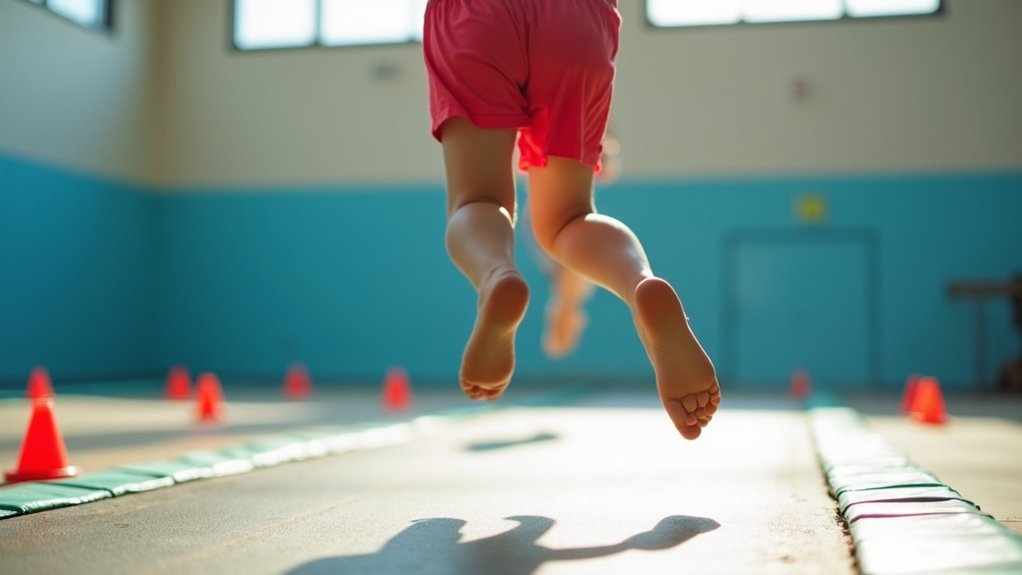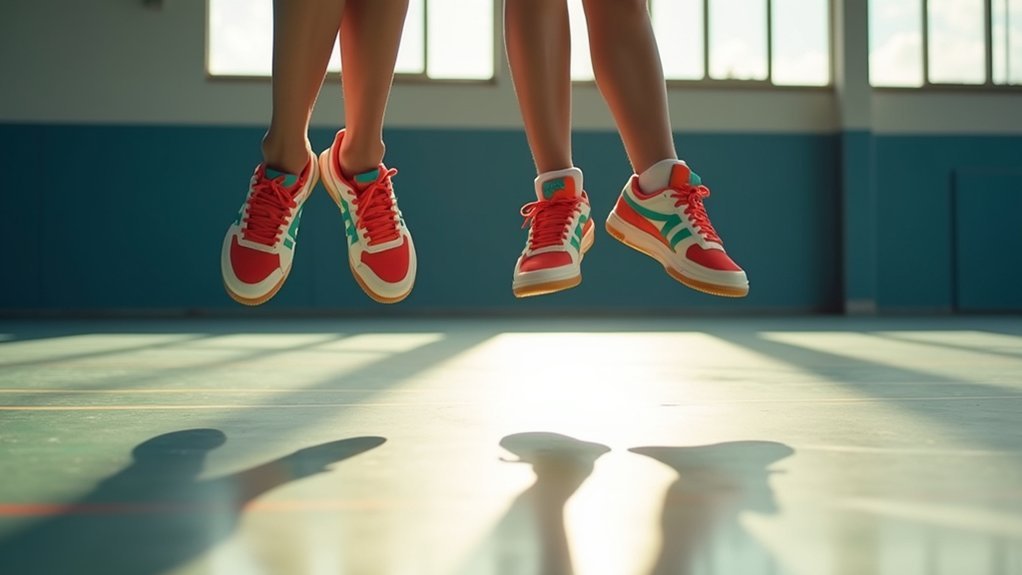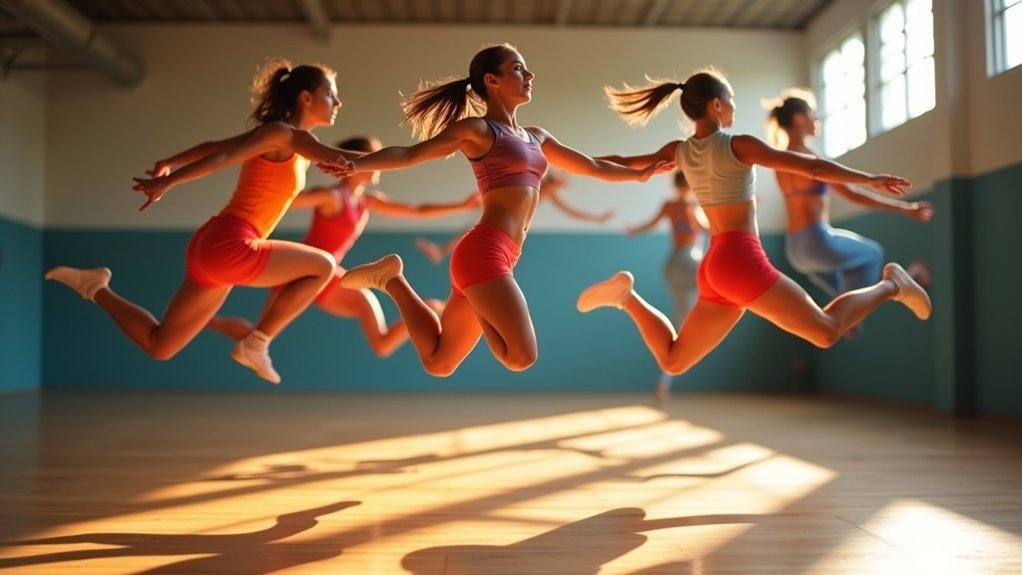Cross-pattern jumps improve your coordination by forcing both brain hemispheres to communicate through the corpus callosum. When you move opposite limbs simultaneously, you’re strengthening neural pathways that enhance proprioception and spatial awareness. These movements activate your core muscles, particularly the transverse abdominis, while establishing rhythmic timing patterns essential for fluid motion. You’ll notice improved balance, reaction time, and overall movement efficiency as your brain develops stronger connections between hemispheres. The benefits extend beyond physical skills into cognitive processing too.
The Neuroscience Behind Cross-Pattern Movements

While many fitness enthusiasts focus primarily on building strength or endurance, cross-pattern movements actually transform your brain at a fundamental level. When you perform exercises that involve crossing the midline of your body, you’re engaging both brain hemispheres simultaneously, forcing them to communicate through the corpus callosum.
This neural connectivity doesn’t just improve your coordination—it enhances overall cognitive function. Each time you execute cross-pattern movements, you’re stimulating sensory and motor neurons bilaterally, creating robust neural pathways that support information processing.
These exercises trigger the production of BDNF, a protein that fosters neuron growth and development. You’ll notice improved proprioception—your awareness of body position—which is essential for balance in all physical activities.
Crossing the midline stimulates BDNF production, enhancing neural growth and proprioceptive awareness for improved balance in every movement.
The brain benefits extend beyond fitness, enhancing skills vital for everyday tasks.
How Alternating Jumps Engage Both Brain Hemispheres
When you perform alternating jumps, you’re actively developing neural pathways that strengthen communication between your brain hemispheres.
These cross-pattern movements synchronize your left and right brain activity through the corpus callosum, enhancing your cognitive processing and motor coordination.
Your brain achieves balanced hemispheric activation during these exercises, which explains why they’re so effective for improving your spatial awareness and overall movement efficiency.
Neural Pathway Development
As you perform cross-pattern jumps, your brain experiences far more than just physical exercise—it undergoes significant neural development.
When you cross the midline during these movements, you’re building stronger neural networks that enhance communication between your brain’s hemispheres.
Cross-pattern movements create lasting changes in your brain functioning through:
- Stimulation of the corpus callosum, strengthening coordination between left and right sides
- Increased production of BDNF, supporting neuron growth and cognitive enhancement
- Development of proprioception, improving your awareness of body positioning in space
- Enhancement of eye-teaming skills essential for reading and writing tasks
Your brain’s neural pathways become more efficient with each jump, creating connections that benefit not just physical coordination but overall cognitive processing.
This neurological development explains why these simple exercises yield such profound results.
Left-Right Brain Synchronization
The remarkable power of cross-pattern jumps lies in their ability to synchronize your brain’s hemispheres. When you perform these cross lateral movements, you’re strengthening the corpus callosum, the bridge connecting your left and right brain regions.
| Brain Region | Benefits | Activities |
|---|---|---|
| Left Brain | Enhanced logical processing | Coordinated motor skills |
| Right Brain | Improved creative thinking | Spatial awareness |
| Both Hemispheres | Better cognitive coordination | Complete brain breaks |
You’ll notice improvements in both physical coordination and mental processing as these exercises create multiple neuropathways. Your brain processes information more efficiently when both hemispheres work together. Try incorporating these movements as brain breaks during study sessions—they’ll help anchor new information while developing essential motor skills. The connection between hemispheric integration and academic performance makes cross-pattern jumps a valuable tool for your cognitive development.
Balanced Hemispheric Activation
Unlike simpler exercises that primarily engage one side of your brain, alternating cross-pattern jumps activate both hemispheres simultaneously in a balanced, rhythmic dance. When you perform these movements, your corpus callosum strengthens, facilitating communication between the hemispheres of the brain.
- Your cognitive function improves as cross-pattern movements integrate both sides of your brain.
- Motor skills develop more efficiently when both hemispheres work together during coordination tasks.
- Your balance naturally enhances as proprioception centers activate in both brain hemispheres.
- Memory retention increases through the heightened neural connectivity these movements create.
This balanced hemispheric activation isn’t just beneficial for physical coordination—it impacts your overall brain function, helping you process information more effectively and respond to your environment with greater awareness and control.
Timing and Rhythm Development Through Rebounding
When you perform cross-pattern jumps on a rebounder, your brain establishes rhythmic timing patterns that strengthen the connection between your thoughts and physical movements.
Your neuromuscular system learns to synchronize opposing limbs more effectively, creating fluid motion sequences that can transfer to other athletic activities.
This consistent rebounding practice trains your body to anticipate and adapt to changing rhythms, developing a natural timing sense that becomes increasingly intuitive with regular practice.
Rhythmic Timing Reinforcement
As you engage in cross-pattern jumps, your brain naturally develops enhanced rhythmic timing capabilities through the continuous rebounding motion.
These cross-lateral movements strengthen the neural connections between both hemispheres of your brain, refining your coordination with each jump.
Your proprioceptive awareness improves greatly when you practice regularly, allowing you to:
- Synchronize your movements with external rhythms, especially when jumping to music
- Develop precise timing between your jump height, rope movement, and foot placement
- Engage your core muscles continuously, supporting balance and stability during complex movements
- Execute movements with greater fluidity and precision as your body learns to anticipate timing requirements
This timing reinforcement creates lasting improvements in your overall movement patterns, translating to better coordination in daily activities and athletic performance.
Neuromuscular Synchronization Patterns
The symphony of cross-pattern jumps creates powerful neuromuscular connections that transform your coordination abilities. When you engage in these jumps, you’re activating both hemispheres of your brain simultaneously, enhancing communication between diverse muscle groups.
Your proprioception improves with each rebounding movement, sharpening your body’s awareness in space. This heightened sensory feedback directly translates to better spatial orientation and precision in everyday movements.
The rhythmic nature of cross-pattern jumps develops your timing capabilities, allowing your brain and body to anticipate and control movements more effectively. Regular practice activates critical neural pathways associated with motor control, strengthening your gross motor skills while improving balance and stability.
You’re not just jumping—you’re rewiring your neuromuscular system for enhanced coordination that benefits all physical activities.
Mini Trampoline Drills for Enhanced Spatial Awareness

Jumping on a mini trampoline offers far more than just cardiovascular benefits; it’s a powerful tool for developing spatial awareness and coordination.
When you incorporate cross patterning exercises on this dynamic surface, you’re engaging both brain hemispheres simultaneously, which dramatically enhances your cognitive function and gross motor skills.
Try these mini trampoline drills to boost your spatial awareness:
- Alternate opposite arm and leg movements during jumps to strengthen neural pathways
- Perform diagonal reaches while maintaining balance to improve proprioception
- Execute 180-degree turns between jumps to challenge your directional awareness
- Practice precise landing positions to enhance eye-foot coordination
You’ll find these exercises adaptable regardless of your age, making them perfect for developing coordination through playful movement that challenges both mind and body.
Core Activation During Cross-Pattern Rebounding
Releasing your body’s core potential happens naturally during cross-pattern rebounding exercises. When you perform cross-pattern jumps, your abdominal and lower back muscles engage simultaneously to maintain proper alignment and stability.
This heightened core activation isn’t just about strengthening—it’s fundamental to improving your total body coordination.
Research confirms that cross-pattern movements stimulate your deep core muscles, particularly the transverse abdominis, more effectively than traditional exercises. As you coordinate opposite limbs during rebounding, you’re strengthening essential neuromuscular connections that enhance your core control and agility.
Cross-pattern rebounding awakens your transverse abdominis through neurological pathways that static exercises simply cannot access.
The benefits extend beyond the gym—this improved functional movement translates to better performance in daily activities and sports.
With consistent practice, you’ll notice enhanced stability and coordination that makes complex physical tasks feel increasingly natural.
Proprioceptive Benefits of Alternating Foot Jumps

When you perform alternating foot jumps, your body enhances its joint position awareness through constant adjustment and sensory feedback from each landing.
Your nervous system receives valuable information about spatial orientation as weight shifts from one leg to another, improving your ability to sense body position without visual cues.
These dynamic movements effectively recalibrate your balance system by challenging the vestibular mechanisms that coordinate movement and stability.
Joint Position Awareness
As you perform alternating foot jumps, your body develops a heightened sense of where your limbs are in space without having to look at them. This proprioception is essential for coordination during lateral movements and physical activities requiring precise joint position awareness.
Your vestibular system activates during these cross-pattern exercises, processing sensory stimulation that strengthens your neuromuscular connections. This leads to:
- Quicker, more accurate movement responses in rapidly changing environments
- Enhanced ability to stabilize joints during dynamic activities
- Improved motor skill development, especially beneficial for athletes and children
- Greater injury prevention through better anticipation of how your body needs to move
Regular practice reinforces these pathways, allowing your brain to subconsciously track joint angles and positions. This makes movements more efficient and reduces the mental effort required for complex physical tasks.
Balance System Recalibration
The dynamic nature of alternating foot jumps triggers your body’s proprioceptive reset mechanisms, effectively recalibrating your entire balance system with each repetition.
When you perform these crossing movements, you’re stimulating your vestibular system through intentional weight shifts that challenge your stability.
Your proprioceptive feedback loops sharpen as you jump, enhancing your body awareness beyond what static exercises provide.
The cross-patterning activates both hemispheres of your brain, strengthening neural communication pathways crucial for advanced coordination.
This bilateral integration is why you’ll notice improved stability in various activities after consistent practice.
Each jump forces your balance system to make micro-adjustments, training your body to respond more efficiently to positional changes.
You’re fundamentally reprogramming your proprioceptive network, creating more robust connections that translate to better coordination in daily movements and athletic performance.
Progressing From Basic to Complex Cross-Pattern Techniques
Mastering cross-pattern techniques requires a methodical progression from foundational movements to complex variations. As you practice basic cross-pattern jumps, you’re laying vital groundwork for timing and rhythm while enhancing brain coordination.
Methodical practice of cross-pattern fundamentals builds the neural pathways essential for mastering complex jump rope variations.
These foundational skills directly support your ability to execute complex movements with greater precision.
- Start with cross crawls to establish fundamental coordination patterns
- Advance to alternate foot jumps to strengthen proprioception and core stability
- Incorporate backward variations to challenge spatial awareness
- Graduate to criss-cross jumps and double unders as coordination improves
Your consistent practice develops muscle memory and cognitive function, enabling total body movement integration.
As both sides of your body learn to work in harmony, you’ll notice improved performance not just in jump rope exercises, but in everyday movements and athletic activities.
Balance Improvement Through Asymmetrical Movements
Why do cross-pattern jumps so effectively enhance your balance? The answer lies in how these asymmetrical movements engage your body.
When you perform cross-pattern exercises, you’re forcing both hemispheres of your brain to communicate simultaneously, processing information from opposite sides of your body.
This neural integration directly improves your balance by strengthening proprioceptive awareness—your body’s ability to sense its position in space. Your core muscles activate to stabilize opposing movements, creating a foundation for better equilibrium in all activities.
The coordination demands of cross movements challenge your stability systems in ways symmetrical exercises cannot. As you practice, you’ll notice improved spatial awareness and greater control during dynamic activities.
This translates to better balance not just during exercise, but in everyday movements and athletic performance.
Cross-Pattern Rebounding for Athletic Performance Enhancement
When elite athletes seek to gain a competitive edge, cross-pattern rebounding exercises often become their secret weapon.
These dynamic movements activate both brain hemispheres simultaneously, enhancing your coordination and reaction time on the field or court.
- Your proprioception improves dramatically, giving you better body awareness during complex athletic movements.
- You’ll develop enhanced motor skills as cross-pattern movements strengthen neural pathways between hemispheres.
- Your agility increases measurably, allowing you to change direction faster in competitive situations.
- Your endurance builds while your core strengthens, supporting overall athletic performance.
Integrating Cross-Pattern Jumps Into Daily Movement Practice
Although many people associate jumping exercises with intense athletic training, cross-pattern jumps can easily become part of your everyday routine without requiring special equipment or extensive time commitments.
By incorporating these movements during short breaks throughout your day, you’ll enhance coordination while crossing the midline of your body, which strengthens communication between brain hemispheres.
You’ll notice improvements in your balance and cognitive function after just a few weeks of consistent practice. Try adding five minutes of cross-pattern jumps to your morning routine or during work breaks to activate sensory and motor neurons.
These simple movements improve proprioception and hand-eye coordination while serving as effective stress relievers. The benefits extend beyond physical fitness, enhancing your eye-teaming skills essential for reading and writing, making these exercises valuable for both your physical and mental well-being.
Frequently Asked Questions
Why Is Cross Patterning Important?
Cross patterning’s important because it strengthens your brain’s communication between hemispheres. You’ll improve cognitive functions, enhance motor skills, and boost proprioceptive awareness, which all lead to better coordination in your daily activities.
What Are the Benefits of Cross Body Movement?
Cross body movements strengthen your brain’s neural connections, boosting cognitive function and coordination. You’ll improve proprioception, eye-teaming skills, and motor function. They’ll enhance your balance, information processing, and overall physical performance in daily activities.
What Is the Point of Cross Crawls?
Cross crawls enhance your brain function by activating both hemispheres simultaneously. You’ll improve coordination, balance, and cognitive skills while reducing stress. They’re particularly beneficial for developing eye-tracking abilities essential for reading and writing.
How to Do the Cross Crawl Exercise?
Stand tall, lift your left knee while touching it with your right elbow. Return to standing, then repeat with right knee and left elbow. Maintain core engagement and a smooth rhythm throughout the movement.
In Summary
Your body’s complex neural networks thrive when you challenge them with cross-pattern jumps. You’re not just building strength—you’re rewiring your brain. As you practice these movements, you’ll notice improved coordination, balance, and athletic ability. The beauty lies in the simplicity: just a few minutes of these jumps daily connects your brain hemispheres and enhances your total body awareness. Start simple, progress gradually, and watch your coordination transform.





Leave a Reply